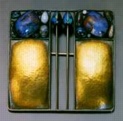
jewelry or jewels
- The work of jewelers: ornaments
or gems / gemstone
such as necklaces, bracelets, or rings, typically made of precious
metals set with gems or
imitation gems.
The British spelling is jewellery.
Examples:

Etruria, Set of jewelry, early 5th century BCE,
late Archaic, gold,
glass, rock
crystal, agate, carnelian; length
of necklace 14 3/16 inches (36 cm); diameter
of disks 2 7/16 inches (6.1 cm); length
of fibula 1 15/16 inches
(5 cm); length of fibulae
1 5/8 inches (4.1 cm); length
of pin 2 7/8 inches (7.3 cm); diameter
of ring with youth intaglio 7/8 inches (2.2 cm); diameter
of ring with Herakles intaglio
15/16 inches (2.4 cm); diameter
of ring with bird intaglio 1 1/16 inches (2.7 cm); diameter
of plain ring 31/32 (2.45 cm); diameter
of ring with lion intaglio 7/8 inches (2.2 cm), Metropolitan
Museum of Art, NY. See Etruscan
art.

Greece, Temple Pendant with the Head of Athena Parthenos,
first half of the 4th century BCE,
gold, enamel, State Hermitage Museum, St. Petersburg,
Russia. See pendant.

Bosporan Kingdom (Black Sea Coast), in Greek
style, Necklace (Pectoral), first half of the
4th century BCE,
gold, enamel, diameter
18.4 cm, State Hermitage Museum, St. Petersburg, Russia. See
pectoral.
![]()
Greek, Alexandria, Egypt, 220 BCE
- 100 BCE,
Hairnet, gold,
garnet, and glass paste, 8 1/2
x 3 1/8 x 3 inches (21.5 x 8 x 7.5 cm), J. Paul Getty Museum,
Malibu, CA.

France, Département Somme, Arm
Ring, 6th century CE,
Frankish, diameter 6.8
cm, silver
gilt, Museum für Vor- und Frühgeschichte,
Berlin.
South America, Central Andes, North Coast, Chímu-Lambayeque, Pair of Earspools, Late Intermediate Period, CE 1000-1470, repoussé gold-copper alloy and silver alloy, diameter of disk 3 x 4 7/16 inches (7.5 x 11.1 cm), Michael C. Carlos Museum, Emery U, Atlanta, GA. See Pre-Columbian art.

Spain, Caravel Pendant, 1580s-1590s, emeralds,
gold, enamel, 9.3 x 6 cm, Hermitage Museum, St.
Petersburg, Russia.

The Netherlands, Swan Pendant, 1590s, gold, enamel,
pearl, diamonds, rubies, 9.2 x 5.9 cm, Hermitage Museum, St.
Petersburg, Russia.

Évrard and Frédéric Bapst (French jewelers, Paris), Crown of the Duchess of Angoulême, 1819-1820, gold and gilded silver set with 40 emeralds and 1031 diamonds, Louvre. See crown.

René Jules Lalique (French, 1860-1945),
Necklace, c. 1895-1905, gold, enamel,
Australian opal, Siberian amethysts; overall diameter
9 1/2 inches (24.1 cm); 9 large pendants:
2 3/4 x 2 1/4 inches (7 x 5.7 cm), 9 small pendants: 1 3/8 x
1 1/4 inches (3.5 x 3.2 cm), Metropolitan Museum of Art, NY.
See Art Nouveau.

Josef Hoffmann (Austrian, 1870-1956) for
Wiener Werkstätte, Square Brooch, silver lattice, repoussé gold, and opal, c. 1905. See opalescence, and secession.

Dinka people, southern Sudan, Beaded Neck Ornament, early 20th century, a central band of patterned Venetian glass beads and brass cartridge cases, surrounded by blue glass beads, British Museum, London. The tradition among the Dinka is that this would have been worn by a man before his wedding,
Also see art careers, attribute, body art, cosmetic, costume, mehndi, pectoral, pendant, plaque, and polymer clay.
https://inform.quest/_art